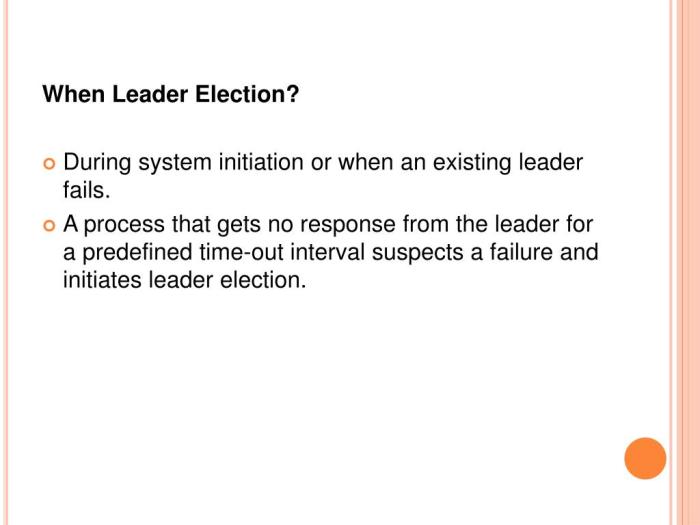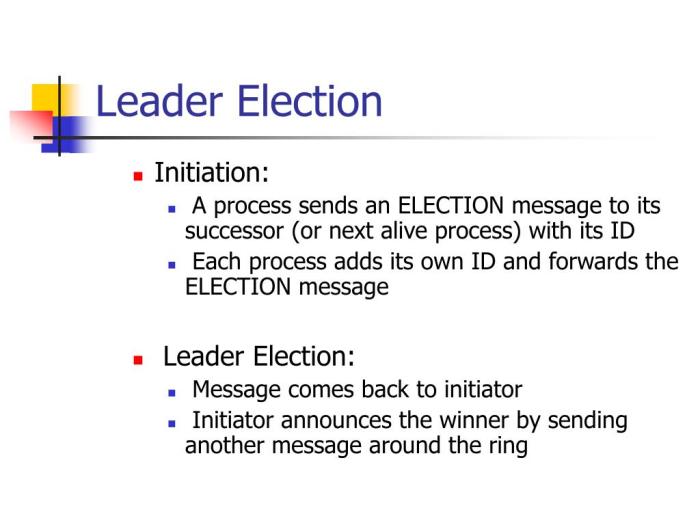Distributed systems, crucial for modern applications, often require a designated leader to manage tasks and maintain consistency. This leader election process is fundamental to ensuring smooth operation and preventing conflicts. Understanding how leader election works in distributed systems is essential for designing, implementing, and maintaining these complex architectures.
This exploration delves into the intricacies of leader election, covering various algorithms, their strengths and weaknesses, and the considerations for implementation and performance. From the basics of distributed systems to the nuances of security, this overview aims to provide a comprehensive understanding of the subject.
Introduction to Distributed Systems Leader Election
Distributed systems, encompassing multiple interconnected computers working collaboratively, are becoming increasingly prevalent in modern computing. These systems offer significant advantages, such as enhanced scalability, fault tolerance, and resource sharing. However, coordinating actions across these diverse components necessitates a mechanism for determining a single point of control or leadership. This is where leader election comes into play.Leader election in a distributed system is the process of designating a single node as the leader among a group of nodes.
This designated leader manages critical tasks such as coordinating actions, maintaining data consistency, and resolving conflicts. This election process is crucial for maintaining the system’s overall functionality and preventing inconsistencies arising from simultaneous operations by multiple nodes. The chosen leader ensures that the system operates smoothly and efficiently.
Types of Distributed Systems and Leader Election
The need for leader election varies depending on the architecture and operational requirements of the distributed system. Different system types have different levels of reliance on a central leader.
| System Type | Description | Necessity for Leader Election | Example Use Cases |
|---|---|---|---|
| Peer-to-Peer | A distributed system where all nodes have equal capabilities and responsibilities. Data and services are typically replicated across all nodes. | Often necessary for coordinating tasks like data synchronization, resource allocation, or managing group operations. Without a leader, coordinating tasks can be complex and prone to conflicts. | File sharing networks, decentralized storage systems, overlay networks. |
| Client-Server | A distributed system with a dedicated server handling requests from multiple clients. The server typically manages resources and services. | Less crucial, but in some scenarios, leader election can be used to manage server failover or ensure consistent data processing. | Web servers, database servers, online gaming servers. |
| Microservices | A distributed system composed of small, independent services. Each service can communicate with other services to perform tasks. | Often necessary to coordinate tasks between services. A leader can be responsible for managing service discovery, load balancing, or task scheduling. | Large-scale applications, e-commerce platforms, social media platforms. |
| Cloud Computing | A distributed system provided as a service. Multiple users share resources, and a leader is required for tasks like resource allocation and managing user access. | Absolutely necessary for tasks such as managing resources, maintaining consistency across various nodes, and coordinating tasks across multiple users. | Cloud storage, cloud computing platforms, data centers. |
Leader Election Algorithms

Leader election is a critical component in distributed systems, ensuring that a single node assumes responsibility for coordinating tasks and maintaining consistency. Effective leader election algorithms are essential for reliable operation, enabling efficient communication and task management across multiple nodes. Different approaches to leader election cater to various system needs and characteristics.
Centralized Approaches
A centralized leader election approach relies on a designated node, often referred to as a coordinator or master, to manage the election process. This node receives requests for leadership and determines the leader based on predefined rules or criteria. This approach simplifies the election process, but it introduces a single point of failure. If the coordinator fails, the entire system may experience disruptions until a new leader is elected.
Decentralized Approaches
Decentralized leader election algorithms distribute the responsibility for election among the nodes. These algorithms typically involve a process where nodes compete and exchange messages until a single node emerges as the leader. Decentralized methods offer improved fault tolerance compared to centralized approaches, as the failure of one node does not necessarily halt the election process.
Specific Algorithms
Several specific algorithms exist for leader election, each with unique characteristics.
Paxos
Paxos is a well-known consensus algorithm that can be used for leader election. It’s designed for high availability and fault tolerance, but it can be complex to implement and understand. The algorithm is highly reliable and can handle failures effectively. It ensures that the chosen leader is consistently recognized by all nodes.
Raft
Raft is another popular consensus algorithm used for leader election, often considered easier to understand and implement than Paxos. It uses a simpler state machine and clear rules, making it a practical choice for many distributed systems. Raft’s design principles emphasize efficiency and clarity, making it a suitable option for applications requiring quick election cycles.
Bully Algorithm
The Bully algorithm is a straightforward decentralized approach to leader election. Nodes directly challenge other nodes to become the leader. If a node is challenged and does not respond, the challenger becomes the leader. While simple, the Bully algorithm may not scale well for larger systems. It relies on a straightforward challenge-response mechanism to determine the leader.
Comparison of Algorithms
| Algorithm | Time Complexity | Message Complexity | Fault Tolerance |
|---|---|---|---|
| Paxos | Variable, depends on network conditions | High | High |
| Raft | Generally faster | Moderate | High |
| Bully | Potentially slow in large systems | Moderate | Moderate |
The table above summarizes the time complexity, message complexity, and fault tolerance of each algorithm. Note that these complexities can vary depending on the specific implementation and network conditions. Time complexity reflects the election process’s duration; message complexity represents the number of messages exchanged; and fault tolerance indicates the algorithm’s resilience to node failures.
Consensus and Fault Tolerance
Leader election in distributed systems necessitates mechanisms for ensuring agreement among nodes despite potential network partitions and failures. Consensus, the agreement on a single value across all nodes, is crucial for electing a leader reliably. This section explores the challenges posed by network partitions and failures, and how different leader election algorithms address them to guarantee fault tolerance and consistency.Leader election algorithms must be resilient to failures and network partitions.
If a node fails during the election process, or if the network divides into isolated segments, the remaining nodes must still be able to reach a consensus on a leader. This resilience is critical for the stability and functionality of the distributed system. The choice of algorithm directly impacts the system’s ability to maintain consistency during these challenging situations.
Challenges of Network Partitions and Failures
Network partitions and node failures are significant hurdles in leader election. A network partition can isolate portions of the system, leading to different nodes electing different leaders in separate partitions. This situation, known as split brain, results in conflicting leadership, hindering the system’s ability to function as a unified entity. Node failures, on the other hand, can disrupt the election process, potentially leading to ambiguity and inconsistencies.
These scenarios require sophisticated algorithms to ensure fault tolerance.
Strategies for Fault Tolerance in Leader Election
Various approaches exist to address the challenges of network partitions and failures in leader election. These approaches focus on achieving consensus and preventing data inconsistencies, which are crucial for reliable leadership selection. These methods typically involve techniques such as timeouts, quorum systems, and leader backup mechanisms.
Consistency Guarantees in Leader Election
Leader election algorithms must guarantee consistency to prevent data inconsistencies and ensure that the system functions correctly. Consistent election results are paramount for the system’s overall reliability. Algorithms achieve this by employing techniques like majority voting, where a leader is chosen based on agreement from a majority of the nodes. This ensures that the chosen leader is recognized by a sufficient number of nodes, thereby minimizing the likelihood of conflicts.
Examples of Algorithms Addressing Fault Tolerance
Various algorithms are designed to handle network partitions and node failures. One example is the Paxos algorithm, which employs a multi-step process for reaching consensus. Paxos uses a sophisticated mechanism to handle failures and ensure that all nodes agree on the same leader. Another approach is Raft, which employs a simpler yet effective strategy for leader election and fault tolerance.
Raft is based on a leader-follower model, with the leader coordinating the election process. These algorithms, and others like ZAB, address the challenges of consensus and fault tolerance, thereby ensuring consistent and reliable leadership selection in distributed systems.
Implementation Considerations
Implementing a leader election algorithm in a distributed system involves careful consideration of various factors, including node roles, data structures, and message passing protocols. A robust implementation must address potential failures and ensure efficient election processes. The chosen algorithm’s performance characteristics, particularly in large-scale systems, are crucial for optimal system operation.
Node Roles and Data Structures
Nodes in a leader election process typically assume distinct roles. These roles often involve coordinating with other nodes to determine the leader. A crucial aspect is the data structures employed to track the election status and the leader’s identity. These structures must be designed to efficiently manage the distributed nature of the system. For example, a node might maintain a list of participating nodes, their current status, and their election progress.
This list is crucial for the node to understand its position in the election. A leader election algorithm needs a suitable data structure for efficient tracking of the election status.
Message Passing Protocols
Message passing protocols form the backbone of leader election in distributed systems. These protocols define how nodes communicate during the election process. Efficient and reliable message delivery is paramount, as election outcomes hinge on the successful exchange of information between nodes. These protocols must be robust enough to handle network partitions and transient failures. Different algorithms use varying message formats, but they all serve to inform other nodes about their status and potentially challenge or accept a leader.
Raft Algorithm Example
The Raft algorithm is a popular leader election algorithm. It leverages a set of messages to coordinate the election process. A table illustrating the steps in a Raft leader election is provided below.
| Step | Action | Node Role | Message |
|---|---|---|---|
| 1 | A node initiates an election by sending election requests to other nodes. | Candidate | Election Request |
| 2 | Nodes receiving election requests respond with election replies. | Voter | Election Reply |
| 3 | A node that receives a majority of election replies becomes the candidate. | Candidate | Vote Grant/Deny |
| 4 | The candidate broadcasts a message to other nodes, indicating it’s the leader. | Leader | Leader Election Confirmation |
| 5 | Other nodes acknowledge the leader. | Voter | Leader Acknowledgment |
The table above Artikels a simplified process of a Raft leader election. Note that in a real-world implementation, there are complexities, such as handling timeouts, ensuring that the leader is consistent across all nodes, and the importance of message acknowledgment.
Performance Evaluation
Assessing the performance of leader election algorithms is crucial for choosing the most suitable algorithm for a specific distributed system. Performance depends on various factors, including network characteristics, node capabilities, and the algorithm’s inherent complexity. Effective evaluation requires understanding the metrics used to quantify these aspects and how they interact with system load.Understanding the performance of leader election algorithms allows for informed decisions regarding system design and resource allocation.
A high-performing algorithm will minimize latency, message overhead, and resource consumption, ultimately contributing to a more efficient and responsive distributed system.
Factors Affecting Algorithm Performance
The effectiveness of a leader election algorithm is influenced by several critical factors. Network latency, the time it takes for messages to travel between nodes, significantly impacts election time. Node processing power, memory, and the algorithm’s complexity directly affect the time taken for each node to perform calculations and participate in the election process. The number of nodes in the system, a fundamental aspect of distributed systems, also plays a critical role.
Increased node count typically leads to a greater communication overhead, and more complex calculations within the algorithm, impacting overall performance.
Metrics for Evaluating Algorithm Performance
Several key metrics are used to assess the performance of different leader election algorithms. Latency, the time taken for the election process to complete, is a critical metric. Throughput, the rate at which the system can handle leader elections, is another essential metric. Message overhead, the total number of messages exchanged during the election, is directly related to communication costs and resource consumption.
High message overhead can negatively impact network performance.
Impact of Network Conditions
Network conditions play a substantial role in algorithm performance. High latency networks, such as those with significant geographical distance or congested network traffic, will increase the time it takes for messages to travel between nodes. This increase in latency will directly translate into a longer election time. Network reliability is another crucial factor; unreliable networks might result in lost messages, forcing re-transmission and potentially delaying or even preventing the election from completing successfully.
In a highly dynamic network environment, where the topology constantly changes, leader election algorithms need to be robust enough to adapt to these changes to maintain election stability and efficiency.
Impact of Node Characteristics
Node characteristics, including processing power and memory capacity, directly influence algorithm performance. Nodes with limited processing power will take longer to perform the necessary computations. Nodes with restricted memory may struggle to handle the algorithm’s data requirements, possibly leading to crashes or timeouts. Algorithms that require less processing power per node will perform better on systems with a heterogeneous mix of nodes with different processing capacities.
The distribution of resources among the nodes also plays a crucial role in overall performance.
Impact of System Load
System load, measured by the number of concurrent leader elections or other system operations, can significantly impact the time taken for a leader election. Increased system load leads to increased contention for resources, such as network bandwidth and node processing power. This contention directly increases the latency of the leader election process. For instance, a system experiencing a high volume of transactions might experience a noticeable increase in the time required for a leader election.
Predicting and managing the impact of system load on leader election time is critical for designing robust and scalable distributed systems. Monitoring system load and adapting algorithms accordingly can ensure acceptable performance under various operational conditions.
Security Considerations

Leader election in distributed systems, while crucial for coordination, is susceptible to various security vulnerabilities. Malicious actors can exploit these vulnerabilities to disrupt the system, gain unauthorized access, or even manipulate the election outcome. Understanding these threats and implementing appropriate security measures are essential for the reliability and trustworthiness of distributed systems.
Potential Security Vulnerabilities
Malicious nodes can employ various strategies to compromise the leader election process. These include Sybil attacks, where a single malicious node impersonates multiple legitimate nodes, thereby skewing the election results. Another threat is denial-of-service (DoS) attacks, where attackers flood the system with spurious requests or messages, disrupting the election process and preventing legitimate nodes from being elected. Furthermore, Byzantine failures, where malicious nodes exhibit unpredictable and potentially harmful behavior, can significantly impact the election outcome and the overall system’s integrity.
Compromised nodes may collude to manipulate the election process or even deliberately fail to participate, creating an uneven playing field.
Malicious Node Disruptions
Malicious nodes can disrupt the election process in several ways. They might attempt to inject false or misleading information into the system, manipulating the election results. They may attempt to overload the network with spurious requests or messages, effectively denying service to legitimate nodes. By impersonating legitimate nodes, they can increase their influence in the election, gaining a disproportionate advantage.
Further, they might create a cascading effect by disrupting the communication links between nodes, causing the entire election process to fail.
Security Measures for Leader Election
Implementing robust security measures is vital to mitigate the risks associated with malicious node behavior. These measures should include verifying the identity of participating nodes to prevent Sybil attacks. Employing cryptographic techniques, such as digital signatures, can ensure the authenticity and integrity of messages exchanged during the election process. Implementing mechanisms for detecting and mitigating DoS attacks is critical.
These mechanisms should include rate limiting and request filtering. Finally, incorporating fault tolerance and consensus mechanisms, like those based on cryptographic proofs, is essential for handling Byzantine failures.
Security Threat Mitigation Strategies
| Security Threat | Mitigation Strategy |
|---|---|
| Sybil Attacks | Node authentication and identity verification, using cryptographic techniques like digital signatures and certificates. |
| DoS Attacks | Rate limiting and request filtering mechanisms, along with robust network monitoring and detection systems. |
| Byzantine Failures | Consensus mechanisms based on cryptographic proofs and fault tolerance protocols. |
| Malicious Collusion | Employing cryptographic techniques to verify the integrity of election results and detect malicious behavior. Using multiple independent election processes and verifying results across multiple processes can also help detect collusion. |
Case Studies
Leader election, a fundamental aspect of distributed systems, finds practical applications in diverse scenarios. Understanding how different algorithms are employed in real-world systems provides valuable insights into the trade-offs and considerations involved. Analyzing specific implementations highlights the impact of factors such as system size, communication patterns, and desired fault tolerance on the selection of an appropriate leader election method.Real-world distributed systems often employ leader election mechanisms to coordinate tasks, manage resources, or ensure data consistency across multiple nodes.
Careful selection of the algorithm is critical for achieving optimal performance and reliability in these applications.
Examples of Leader Election in Real-World Distributed Systems
Various distributed systems leverage leader election mechanisms. Consider a cluster of web servers, where a single server acts as the leader responsible for distributing incoming requests. This leader election ensures load balancing and prevents conflicting updates to shared data. Another example is a distributed file system, where a leader is needed to coordinate file operations and maintain consistency across different nodes.
These examples highlight the ubiquitous nature of leader election in distributed systems.
Leader Election Algorithms in Specific Applications
Different leader election algorithms are tailored to specific application needs. The Paxos algorithm, known for its resilience to failures, is often used in distributed databases where high availability is paramount. The Raft algorithm, with its simpler implementation and suitability for larger systems, is frequently employed in distributed storage systems. The choice of algorithm depends on factors like the required fault tolerance, the expected system size, and the communication overhead.
Factors Influencing Algorithm Selection
Several factors influence the choice of a leader election algorithm. These include the system’s size and complexity, the frequency of leader changes, the network characteristics, and the level of fault tolerance required. In a small, tightly-coupled system, a simple algorithm might suffice. Conversely, in a large, geographically distributed system with high fault tolerance requirements, a more complex algorithm might be necessary.
The specific application requirements and constraints significantly impact the algorithm selection.
- System Size and Complexity: A small system with minimal communication overhead might benefit from a simpler algorithm like a centralized approach. Large, complex systems, however, might require more sophisticated algorithms like Paxos or Raft to handle the increased complexity and potential for failures.
- Frequency of Leader Changes: Applications requiring frequent leader changes might benefit from algorithms with faster election processes. Systems where leader changes are infrequent can afford to use algorithms that prioritize stability and robustness over speed.
- Network Characteristics: The network’s topology, latency, and bandwidth directly impact the performance of different algorithms. Algorithms optimized for low-latency networks may perform poorly in high-latency environments. Likewise, algorithms requiring extensive communication might not be suitable for networks with limited bandwidth.
- Fault Tolerance: Applications with high availability requirements often favor algorithms that can tolerate failures. Paxos, for instance, is renowned for its robust fault tolerance, making it suitable for distributed databases and other critical applications.
Case Study: Distributed Database System
Leader election is crucial in distributed database systems for maintaining data consistency and ensuring efficient operations across multiple nodes. In a specific distributed database system, a leader is chosen to coordinate transactions and manage data updates. The Raft algorithm is often used due to its simplicity and ability to handle failures. The leader manages concurrent access to shared data, preventing conflicts and ensuring data integrity.
Practical Applications
Leader election, a fundamental aspect of distributed systems, finds diverse applications across various domains. Its ability to designate a single authoritative entity within a network enables efficient resource allocation, fault tolerance, and scalability. This section details the practical applications of leader election, focusing on its role in enabling efficient resource allocation and management, and providing real-world examples of distributed systems leveraging this concept.
Applications in Cloud Computing
Leader election plays a crucial role in managing and coordinating tasks in cloud environments. A designated leader can effectively distribute workloads across numerous virtual machines, optimizing resource utilization and ensuring consistent performance. This is particularly important in tasks like container orchestration, where a leader manages the deployment, scaling, and health monitoring of containers.
Applications in Big Data Processing
In big data processing frameworks, leader election is essential for coordinating tasks across numerous nodes. The leader election mechanism facilitates the efficient distribution of data partitions and ensures that processing tasks are completed in a coordinated and optimized manner. For instance, in Hadoop, the NameNode acts as a leader responsible for managing the file system and tracking data blocks across the cluster.
This leadership role ensures efficient data access and processing across the entire system.
Resource Allocation and Management
Leader election significantly facilitates efficient resource allocation and management in distributed systems. By designating a single leader, the system can make informed decisions regarding resource allocation, balancing the demands of different tasks or users. The leader can track available resources, assign tasks to appropriate nodes, and manage contention for resources, ensuring a fair and efficient allocation process. For example, a leader in a cloud environment can monitor the available processing power and memory across different virtual machines and assign tasks accordingly.
Real-World Examples
Several distributed systems leverage leader election for their operation. Apache Kafka, a distributed streaming platform, utilizes a leader election process to choose a leader for each partition of data. This leader manages the ingestion and distribution of messages, ensuring efficient data handling across the network. Similarly, Kubernetes, a container orchestration platform, employs leader election to select a controller responsible for managing the deployment and scaling of containers.
This ensures that tasks are distributed effectively and consistently.
Scalability in Distributed Systems
Leader election significantly contributes to scalability in distributed systems. By delegating tasks and responsibilities to a designated leader, the system can handle a growing number of nodes and tasks more efficiently. This centralized leadership role allows the system to adapt to increased workloads and user demands without significant performance degradation. The leader election process ensures that the system remains responsive and scalable as the network size and complexity increase.
The selection of the leader is frequently based on criteria such as node availability, load balancing, or a combination of factors, promoting resilience and optimal performance in a distributed environment.
Emerging Trends
The field of distributed systems leader election is constantly evolving, driven by the increasing complexity and scale of modern applications. Emerging trends reflect a push towards more robust, efficient, and secure mechanisms for selecting leaders in distributed environments. These advancements aim to address the challenges posed by fault tolerance, scalability, and performance under heavy load.
Advancements in Consensus Algorithms
Modern leader election algorithms are increasingly incorporating sophisticated consensus protocols. These protocols ensure agreement among distributed nodes on a shared decision, such as electing a leader. This approach enhances fault tolerance and reliability, mitigating the impact of node failures or network partitions. Examples include more advanced variants of Paxos and Raft, designed to handle specific needs of leader election in a distributed system.
Decentralized Leader Election Approaches
Traditional leader election often relies on a central authority or a predetermined election process. Emerging trends are shifting towards decentralized approaches. These methods involve distributing the election process among multiple nodes, enhancing resilience to failures in specific parts of the system. This distributed election process avoids a single point of failure and reduces the overhead associated with centralized election protocols.
Integration with Blockchain Technology
Blockchain technology is increasingly being incorporated into leader election mechanisms. Blockchain’s inherent immutability and transparency can provide a secure and auditable record of the election process. This integration ensures a verifiable and tamper-proof election process, improving trust and security in distributed systems. For example, applications requiring highly secure and verifiable leader selection within a network can leverage the immutable nature of blockchain records.
Leveraging Quantum Computing Concepts
While still in the early stages of development, quantum computing concepts are beginning to influence the design of leader election algorithms. Researchers are exploring quantum-inspired algorithms to potentially achieve significantly faster and more efficient leader election processes in distributed systems. This is a nascent field with potential for groundbreaking advancements in the future. Early research suggests that some quantum algorithms could potentially reduce the time complexity of leader election compared to classical methods.
Comparison of Emerging Trends
| Trend | Potential Impact ||——————————————|——————————————————————————————————————————————————————————————————–|| Advanced Consensus Algorithms | Improved fault tolerance, reduced latency in leader election, enhanced resilience to node failures.
|| Decentralized Approaches | Increased resilience to failures, reduced reliance on a single point of failure, potential for scalability in larger systems.
|| Blockchain Integration | Enhanced security and trust in the election process, verifiable election records, improved auditability.
|| Quantum Computing Concepts | Potential for dramatically faster and more efficient leader election, but still largely theoretical and in the early stages of development.
|
Future Directions

The field of distributed systems leader election is constantly evolving, driven by the increasing complexity and scale of modern applications. As distributed systems become more pervasive and integrated into our daily lives, the need for robust and efficient leader election mechanisms will only grow. Future research will focus on adapting existing techniques to meet new challenges and exploring novel approaches to address emerging issues.
Research Areas in Leader Election
Research into leader election algorithms is multifaceted, encompassing theoretical advancements and practical implementations. Potential research areas include developing leader election algorithms tailored for specific application domains, such as real-time systems or high-performance computing. Another promising area is exploring the use of machine learning techniques to dynamically adapt leader election protocols to changing system conditions.
Future Directions for Leader Election Algorithms
Leader election algorithms need to adapt to the increasing heterogeneity and dynamism of modern distributed systems. This includes developing algorithms resilient to transient failures, ensuring fast convergence even with large numbers of nodes, and optimizing for low latency. Research in this area also includes investigating the impact of network topology on leader election performance and developing algorithms that can adapt to changes in the network topology.
Advancements in Leader Election Technologies
Future advancements in leader election technologies may include the development of hybrid approaches that combine different election strategies to address specific needs. For example, a hybrid algorithm might leverage a fast, but potentially less reliable, initial election phase followed by a more robust confirmation phase. Additionally, the use of cryptographic techniques for enhanced security and trust in leader election is expected to become increasingly important.
New Challenges and Opportunities in Leader Election
The growing adoption of cloud computing and edge computing introduces new challenges for leader election. Distributed systems in these environments are often characterized by dynamic node membership, unpredictable network conditions, and potentially limited resources. These present both challenges and opportunities for research. The development of leader election algorithms that can effectively handle these dynamic environments will be critical for the continued success of distributed systems.
Security Considerations in Leader Election
Security is paramount in leader election, particularly in systems handling sensitive data. Future research will likely focus on developing election mechanisms resistant to various attacks, such as denial-of-service attacks targeting the election process or attempts to manipulate the election outcome. The development of robust authentication and authorization protocols will be crucial in ensuring the integrity and reliability of the leader election process.
Summary
In conclusion, leader election is a critical component of distributed systems, enabling efficient coordination and fault tolerance. We’ve examined various algorithms, highlighting their trade-offs in terms of complexity and resilience. The discussion also underscored the importance of security and performance considerations. The future of leader election algorithms is promising, with emerging trends pushing the boundaries of distributed computing.
FAQ Compilation
What are the common failure scenarios in distributed leader election?
Network partitions, node failures, and malicious actors can all disrupt the election process. These scenarios highlight the need for robust algorithms that can adapt to such conditions.
How does the choice of leader election algorithm affect system performance?
Different algorithms have varying time and message complexities. Choosing the right algorithm depends on the specific needs of the application, balancing factors such as latency, throughput, and fault tolerance.
What role does consensus play in ensuring consistency during leader election?
Consensus algorithms ensure that all nodes agree on the elected leader. This agreement is crucial for maintaining consistency and avoiding data inconsistencies within the system.
How can malicious nodes be prevented from disrupting the leader election process?
Security measures, such as authentication and authorization mechanisms, are vital to mitigate the risk of malicious nodes manipulating the election process. This includes using cryptographic techniques to ensure that only legitimate nodes can participate.


